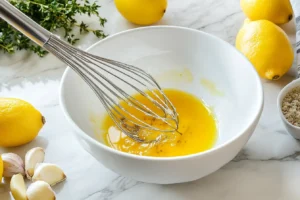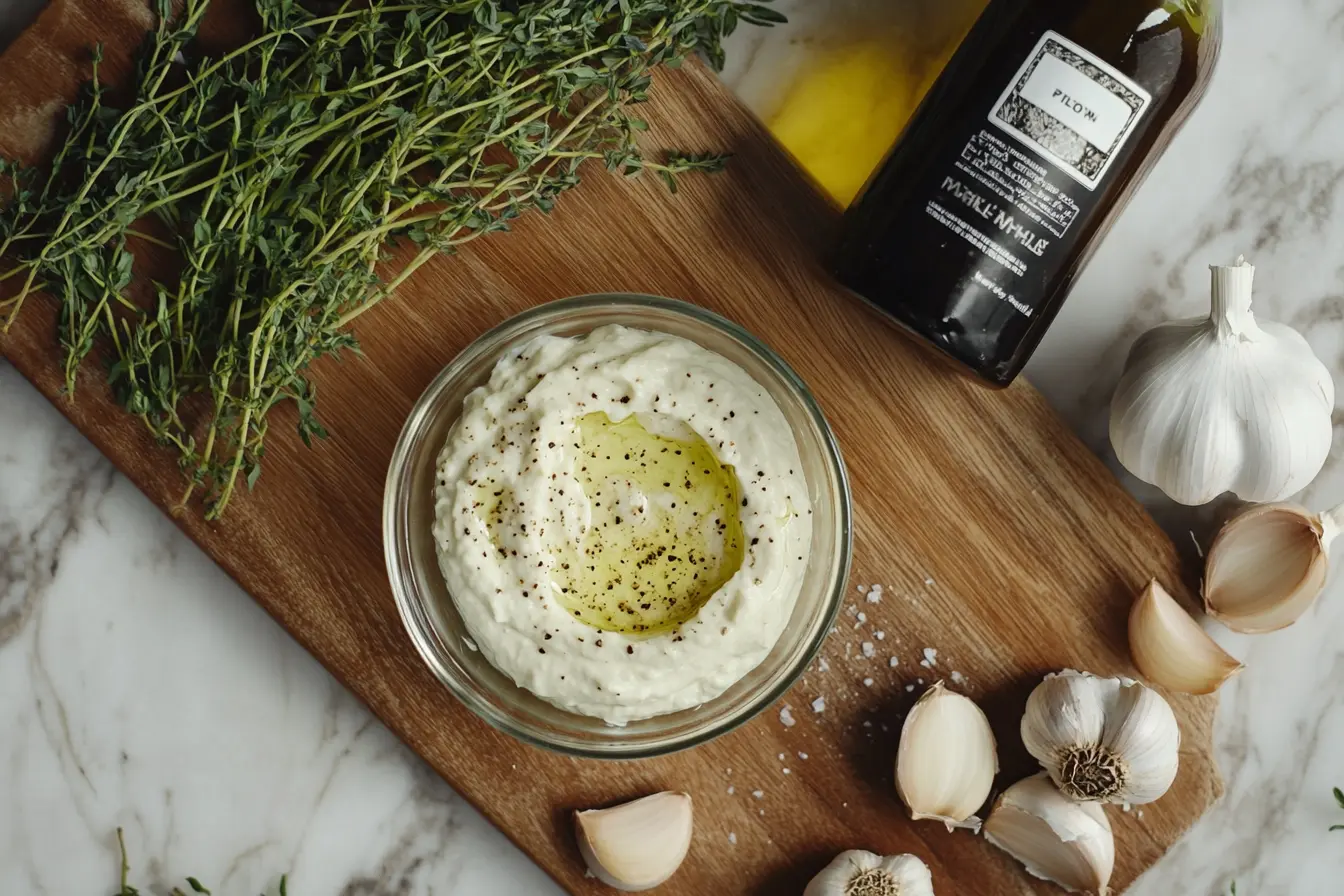Making a gourmet condiment like truffle aioli at home might sound fancy, but it’s surprisingly simple! With a few essential ingredients and some easy steps, you can whip up a velvety, flavorful sauce that elevates any meal. Whether it’s used as a dip, spread, or finishing touch, truffle aioli transforms everyday dishes into culinary masterpieces. This article will guide you through every detail of creating the perfect truffle aioli, exploring its history, ingredients, and uses, along with tips for avoiding common pitfalls.
Introduction to Truffle Aioli
What Is Truffle Aioli?
Truffle aioli is a luxurious twist on the traditional aioli sauce, which hails from Mediterranean cuisines. Aioli itself is a creamy emulsion of garlic, egg yolks, olive oil, and lemon juice. But when you add truffle oil, it becomes a game-changer! Truffle oil infuses the aioli with the earthy, umami-packed essence of truffles, giving it a rich and aromatic flavor profile.
Originally a humble garlic sauce, aioli gained widespread fame as chefs began to innovate with ingredients like mustard, herbs, and, of course, truffles. Truffle oil, made by infusing olive oil with the essence of black or white truffles, became the perfect partner to this creamy condiment. Today, truffle aioli is a star in both home kitchens and high-end restaurants worldwide.
Why You’ll Love Truffle Aioli
There’s something magical about this gourmet aioli. It’s indulgent yet surprisingly simple to make. What makes truffle aioli irresistible? Its versatility! You can use it as a dip for fries, a spread for sandwiches, or even a drizzle over roasted veggies. The umami notes of truffle oil bring a bold yet refined taste to any dish, making it a must-have for food enthusiasts.
If you’re looking to impress guests—or just treat yourself—truffle aioli is a foolproof way to do it. With minimal effort, you’ll enjoy restaurant-quality flavor right in your own kitchen. And the best part? You can customize it to suit your preferences by tweaking the ingredients or consistency.
Origins and Popularity
Though truffle aioli feels modern, it’s rooted in culinary history. Traditional aioli sauce dates back centuries to regions like Provence, France, and Catalonia, Spain. These Mediterranean cultures prized the simplicity of combining garlic and olive oil into a silky, flavorful sauce. Fast-forward to today, and chefs have elevated this simple creation with ingredients like white and black truffles, turning it into a global gourmet trend.
Interestingly, truffle aioli isn’t just about luxury—it’s about enhancing natural flavors. Truffles, known as the “diamonds of the kitchen,” have been celebrated for their unique aroma and taste for centuries. Pairing them with creamy aioli creates a balance of richness and boldness that’s simply unforgettable.
Ingredients for the Perfect Truffle Aioli
Essential Ingredients for Homemade Truffle Aioli
Creating a velvety, flavorful truffle aioli recipe starts with high-quality, simple ingredients. Each component plays a key role in achieving the perfect balance of richness and umami. Here’s what you’ll need:
- Egg Yolks: These are the backbone of any aioli. Egg yolks act as an emulsifier, binding the oils and liquids together into a creamy consistency.
- Fresh Garlic: No aioli is complete without garlic. It provides that signature bold, savory flavor that balances the richness of the sauce.
- Truffle Oil: This is the star of the show. Opt for high-quality black or white truffle oil—each offers a unique depth of flavor. (More on choosing truffle oil below!)
- Olive Oil: A generous helping of extra virgin olive oil adds richness and ensures a silky texture.
- Lemon Juice: A touch of acidity cuts through the richness and brightens the flavor.
These ingredients come together to create a sauce that’s not only indulgent but also incredibly versatile.
Optional Add-Ins to Customize Your Recipe
One of the joys of making truffle aioli at home is the freedom to customize it to your taste. Here are a few popular additions:
- Mustard: A dash of Dijon mustard adds a subtle tanginess and helps stabilize the emulsion.
- Herbs: Fresh parsley, chives, or tarragon can lend a herbal note that complements the truffle flavor beautifully.
- Salt and Pepper: Don’t forget to season your aioli! A pinch of salt enhances all the flavors, while fresh cracked pepper adds a touch of heat.
Finding the Best Truffle Oil
Not all truffle oils are created equal. To achieve that gourmet quality, it’s essential to pick a truffle oil that’s authentic and flavorful.
- Black Truffle Oil vs. White Truffle Oil: Black truffle oil delivers a deep, earthy, and robust flavor, while white truffle oil is lighter and more garlicky with a hint of muskiness. Both are excellent options, depending on your flavor preferences.
- Avoid Artificial Flavors: Some commercial truffle oils rely on synthetic aromas, which can taste overpowering or fake. Look for oils that are infused with real truffle essence.
Why Ingredient Quality Matters
Truffle aioli is a simple recipe, so every ingredient shines through. Using the freshest garlic, the creamiest egg yolks, and the best-quality truffle oil makes all the difference. After all, great dishes are built on great ingredients!
Step-by-Step Instructions for Making Truffle Aioli
How to Make Truffle Aioli at Home
Making truffle aioli at home is surprisingly simple, even for beginners. The process requires just a handful of ingredients and a little bit of patience. Whether you prefer whisking by hand or using a food processor, the result is a creamy, luxurious sauce bursting with flavor. Let’s break it down!
Preparation and Equipment Needed
 Before diving in, make sure you have the following tools and equipment ready:
Before diving in, make sure you have the following tools and equipment ready:
- A mixing bowl for whisking or a food processor for quicker emulsification.
- A whisk, if you’re doing it manually.
- Measuring cups and spoons to ensure ingredient accuracy.
- A garlic press or fine grater for mincing the garlic.
Having everything prepped beforehand makes the process seamless—and less stressful!
Simple Recipe for Truffle Aioli
Here’s a foolproof recipe to create your own truffle aioli:
- Start with the egg yolks: In a clean mixing bowl or food processor, add two egg yolks. Whisk or pulse gently to break them up.
- Add the garlic: Mince one clove of garlic finely, or use a garlic press for extra smoothness. Add it to the bowl and whisk or pulse again to combine.
- Begin emulsifying: Gradually drizzle in olive oil (about ½ cup) while continuously whisking or with the food processor running on low. Pour slowly to ensure the mixture doesn’t separate.
- Incorporate truffle oil: Once the aioli starts to thicken, drizzle in 1–2 tablespoons of truffle oil. Adjust the quantity to suit your taste—less for subtlety, more for boldness.
- Season and finish: Add 1 teaspoon of fresh lemon juice for brightness, then season with salt and pepper to taste. If the consistency is too thick, thin it out with a few drops of water or additional lemon juice.
Voilà! Your homemade truffle aioli is ready to elevate any dish you pair it with.
Tips for Perfect Texture and Flavor
- Consistency is key: If your aioli feels too thick or too runny, don’t panic! For a thicker sauce, add more olive oil slowly. To thin it, use a tiny bit of water or lemon juice.
- Truffle oil adjustment: Taste as you go! Truffle oil can be intense, so add it in increments to avoid overpowering the other flavors.
- Room temperature ingredients: Always use room-temperature eggs and oils to ensure a smooth emulsion.
Quick Note on Emulsions
If your mixture separates or doesn’t thicken as expected, don’t fret—it happens to the best of us! To fix a broken emulsion, add a few drops of water and whisk vigorously until it comes back together.
Creative Ways to Use Truffle Aioli
Delicious Applications for Truffle Aioli
Once you’ve whipped up your creamy, flavorful truffle aioli recipe, the possibilities for using it are practically endless. This luxurious condiment has the versatility to complement almost any dish, adding an indulgent twist to everyday meals. Here are some of the most popular—and creative—ways to enjoy truffle aioli.
As a Dip

Let’s start with the obvious: truffle aioli makes an exceptional dip! The creamy texture and rich, earthy flavor are perfect for:
- Crispy Fries: Pair your favorite fries—whether classic, sweet potato, or zucchini—with a side of truffle aioli for an instant upgrade.
- Vegetable Crudités: Use it as a dip for raw veggies like carrots, celery, bell peppers, or cherry tomatoes for a healthier snack option.
- Seafood Delights: Serve it alongside calamari, shrimp, or crab cakes for a restaurant-quality appetizer.
The combination of creamy aioli and crispy or fresh textures creates a satisfying balance that your taste buds will thank you for!
As a Spread
If you’re a sandwich lover, truffle aioli might just become your go-to spread. Its bold flavor enhances simple sandwiches and elevates gourmet burgers alike.
- Burgers: Smear a generous layer of truffle aioli on your bun for a flavor-packed bite every time. Pair it with melted cheese, caramelized onions, or sautéed mushrooms for even more indulgence.
- Paninis and Wraps: Replace your usual mayo or mustard with truffle aioli for a more refined touch. It pairs wonderfully with roasted chicken, turkey, or grilled vegetables.
The richness of truffle oil and garlic adds depth to these dishes, transforming them from ordinary to extraordinary.
As a Finishing Touch
Truffle aioli isn’t just a dip or spread—it’s also a fantastic finishing touch for a variety of cooked dishes. A drizzle of this creamy sauce can elevate the simplest of meals.
- Roasted Vegetables: Drizzle it over roasted carrots, asparagus, or Brussels sprouts for a sophisticated side dish.
- Grilled Meats: Use it as a topping for steaks or chicken to add a touch of umami richness.
- Seafood: A dollop of truffle aioli on grilled salmon or seared scallops makes for a gourmet dining experience at home.
Its creamy, bold flavor adds a luxurious note to any dish, making it ideal for weeknight meals and dinner parties alike.
Elevate Any Dish Instantly
The beauty of truffle aioli lies in its ability to take a dish from “just okay” to “wow!” Whether you’re hosting friends or indulging on your own, it’s a condiment that delivers unforgettable flavor.
With so many delicious uses for truffle aioli, it’s time to explore its health benefits and nutritional profile. Curious about how this gourmet sauce fits into your diet? Let’s break it down next!
Nutritional Information and Dietary Considerations
Is Truffle Aioli Healthy?
Truffle aioli is undeniably indulgent, but it also has nutritional elements that can fit into a balanced diet when consumed in moderation. Let’s unpack the nutritional profile of this creamy, flavorful condiment.
Nutritional Breakdown
Here’s what you can expect in a standard 1-tablespoon serving of homemade truffle aioli:
- Calories: Around 100 calories per tablespoon, primarily from healthy fats.
- Fats: Roughly 11 grams of fat, with most coming from the olive oil and truffle oil. These are unsaturated fats, which can be heart-healthy when consumed in moderation.
- Protein: Minimal, about 0.3 grams per serving.
- Carbohydrates: Virtually zero carbs, making it a great option for low-carb diets.
- Cholesterol: Approximately 10 mg due to the egg yolks.
Benefits of Key Ingredients
- Olive Oil: Packed with antioxidants and monounsaturated fats, olive oil is well-known for its anti-inflammatory and heart-health benefits.
- Garlic: Rich in allicin, garlic has antibacterial properties and may support immune health.
- Truffle Oil: While mainly for flavor, truffle oil made with real truffles may contain trace nutrients and antioxidants that are beneficial to the body.
Truffle aioli provides a concentrated source of calories due to its fat content, but these fats are largely unsaturated and can support overall health when included as part of a balanced diet.
Dietary Modifications
Want to enjoy truffle aioli while adhering to dietary restrictions or preferences? Here are some tips to make it work for you:
- Keto and Paleo-Friendly: Truffle aioli is naturally low in carbs, making it an ideal choice for keto and paleo diets. Ensure you’re using high-quality oils without additives for a clean recipe.
- Vegan Substitution: Swap the egg yolks with aquafaba (the liquid from canned chickpeas) or vegan mayonnaise. Both work well as plant-based emulsifiers.
- Egg-Free Option: If you’re avoiding eggs but not vegan, you can use pasteurized egg substitutes or simply rely on store-bought egg-free mayonnaise as the base.
Serving Sizes and Moderation
While delicious, it’s important to remember that truffle aioli is calorie-dense. A little goes a long way! Stick to a serving size of about 1–2 tablespoons to keep your calorie intake in check while still enjoying its bold flavor.
Final Thoughts on Health and Nutrition
The beauty of truffle aioli lies in its ability to combine indulgence with healthy, natural ingredients like olive oil and garlic. By controlling portion sizes and opting for high-quality ingredients, you can enjoy this gourmet condiment guilt-free.
Common Mistakes to Avoid When Making Truffle Aioli
Avoiding Pitfalls in Your Truffle Aioli Recipe
Making truffle aioli is straightforward, but like any recipe, it has its challenges. While the process is simple, a few common mistakes can lead to frustrating results. Thankfully, with a little attention to detail and preparation, you can easily avoid these pitfalls. Let’s explore the most frequent missteps and how to fix or prevent them.
Mistake 1: Overpowering with Truffle Oil
Truffle oil is a potent ingredient, so less is more! Many first-timers make the mistake of using too much, which can overpower the delicate balance of flavors in the aioli.
- Solution: Start small! Add one tablespoon of truffle oil, taste, and adjust as needed. Remember, you can always add more, but it’s impossible to take it out once it’s mixed in.
Another tip? Pair the oil with a high-quality olive oil. This ensures the truffle flavor shines without being overwhelming.
Mistake 2: Broken Emulsions
An emulsion is the heart of any aioli, but it’s also where things can go wrong. If the mixture separates or doesn’t thicken, it can be discouraging. This typically happens when you add the oil too quickly or don’t whisk it consistently.
- Solution: Patience is key! Always add the oil gradually, starting with just a few drops. Whisk continuously or let your food processor run on a low setting to ensure the ingredients combine smoothly.
If your aioli separates, don’t worry—it’s not ruined! To fix it, start with a clean bowl, whisk one egg yolk, and slowly add the broken mixture back in while whisking vigorously.
Mistake 3: Using Low-Quality Ingredients
Since truffle aioli is made with just a handful of ingredients, their quality has a huge impact on the final result. Cheap or artificial truffle oil, stale garlic, or low-quality olive oil can lead to a disappointing flavor.
- Solution: Choose fresh, high-quality ingredients. Opt for real truffle-infused oil (avoid synthetic products), fresh garlic cloves, and a good extra virgin olive oil. Investing in quality pays off in both flavor and texture.
Tips for Storing Truffle Aioli Properly
Even after successfully making truffle aioli, improper storage can spoil it. Since it’s made with raw egg yolks, the sauce is perishable and must be handled carefully.
- Refrigerate Immediately: Once made, transfer the aioli into an airtight container and refrigerate it promptly.
- Shelf Life: Homemade truffle aioli typically lasts 3–5 days in the fridge. If it smells off or the texture changes, it’s best to discard it.
- Avoid Contamination: Always use a clean spoon to scoop out portions to prevent introducing bacteria into the container.
Bonus Tip: Experiment and Adjust!
Don’t be afraid to tweak the recipe as you go. Add an extra splash of lemon juice for brightness, or mix in herbs like chives for added depth. By personalizing your truffle aioli, you can make it uniquely yours.
Final Word on Common Mistakes
When making truffle aioli, patience and attention to detail are your best friends. By avoiding these common mistakes and following a few simple tips, you’ll master the recipe in no time. Up next, let’s tackle some of the most frequently asked questions about this luxurious condiment!
Frequently Asked Questions About Truffle Aioli
Can I Make Truffle Aioli Without Eggs?
Yes! You can make an egg-free truffle aioli using alternatives like aquafaba (chickpea water) or vegan mayonnaise. Aquafaba mimics the emulsifying properties of eggs, creating a smooth and creamy texture. Simply whisk it with truffle oil, lemon juice, garlic, and seasoning for a delicious vegan-friendly version.
How Long Does Truffle Aioli Last in the Fridge?
Truffle aioli stays fresh for about 5 to 7 days when stored in an airtight container in the refrigerator. To maintain its flavor and quality, always use clean utensils when scooping it out and avoid leaving it at room temperature for extended periods.
What Dishes Pair Best with Truffle Aioli?
Truffle aioli is incredibly versatile! It pairs well with crispy fries, roasted vegetables, grilled meats, seafood, and even gourmet burgers. You can also drizzle it over roasted potatoes, use it as a dip for artichokes, or spread it on sandwiches for an extra layer of flavor.
Can I Use Fresh Truffles Instead of Truffle Oil?
Absolutely! Fresh truffles add an intense, earthy aroma to your aioli. To substitute, finely grate black or white truffles into the mixture and let the flavors infuse for a few hours. Since fresh truffles are milder than truffle oil, you may need to use more for a pronounced taste.
What’s the Difference Between Black and White Truffle Aioli?
Black truffle aioli has a deep, robust, and earthy flavor, making it perfect for heartier dishes like steaks and roasted vegetables. White truffle aioli is more delicate with a garlicky, slightly nutty aroma, ideal for seafood, pasta, and lighter dishes. Choose based on your flavor preference and the dish you’re serving!

